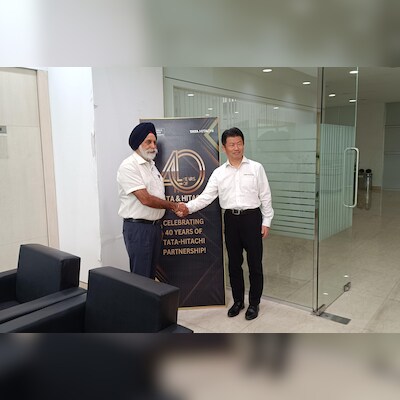Atmanirbharta has been part of our culture: Tata Hitachi MD Sandeep Singh
Sandeep Singh, Managing Director, Tata Hitachi, with Takahiro Kobayashi – Alternate Director
Long before Atmanirbhar or self-reliance became a buzzword, Tata Hitachi, a joint venture between Tata Motors and Japan’s Hitachi Construction Machinery Company, had embraced it. The 40-year partnership, which provides construction equipment to feed India’s infrastructure and mining needs, was set up to boost localisation. And it’s looking to up it further.
“Atmanirbharta has been part of our culture from day one,” Tata Hitachi managing director Sandeep Singh says, addressing media persons at the company’s Kharagpur plant to mark the 40th anniversary of the collaboration between the two companies.
Set up in 2009, the Kharagpur facility in West Bengal is spread over 250 acres and happens to be one of the largest excavator plants in South East Asia. The Dharwad manufacturing site in Karnataka goes back to 1998.
Singh points out that localisation is Tata Hitachi’s biggest strength. The Tata group brings in the expertise of localisation – the know-how to develop and indigenise products being brought in from Japan. Hitachi brings in the technology. “We have a big advantage where we have two partners complementing each other.”
On average, 65 per cent of components are localised and the company is looking to increase it to 70 per cent in two to three years. Every year, depending on the product, two to five per cent of localisation takes place, Singh says.
The advantage of localisation, Singh explained, is that it helps to control cost and inventory apart from generating employment for local people.
“We have 15 people from Japan based between Dharwad, Kharagpur and Bengaluru (company headquarters). They guide and train people to maintain quality levels and localisation.”
Tata Hitachi believes that the joint venture stands as a shining example of what can be achieved through synergy and cooperation.
The company, however, had started its journey as a construction equipment division of Tata Engineering and Locomotive Company (now Tata Motors) in Jamshedpur back in 1961.
A partnership with Hitachi in the form of a technical collaboration came about in 4. The division was later spun off into a separate company, Telcon, in which Hitachi picked up a 20 per cent stake. Today, the Japanese entity holds 60 per cent in the joint venture while the balance is with Tata Motors.
As far as the export market is concerned, the company plans to focus on the Middle East and Africa. But it’s a small part of the business, at about 5 per cent.
But with the Indian government’s focus on infrastructure, it’s the domestic market that Tata Hitachi is betting big on. In FY24, the company clocked in a turnover of Rs 5,000 crore.
Tata Hitachi has a 24 per cent market share in excavators – about five years back it was at 30 per cent. But the major competition right now is from Chinese imports. The company is already discussing with the government to contain it.
This year has been ‘tricky’ on the demand side with the general election and heavy rains. “We are not looking at big growth. But we are confident that the second half will be much better,” Singh said.
1984: Enters into technical collaboration with Hitachi Construction Machinery
2000: Telco and Hitachi sign JV for 80:20 stake in Telcon
2005: Tata Motors and Hitachi sign new JV for 60:40 stake
2010: Tata Motors and Hitachi sign JV for 40:60 stake
First Published: Jul 02 2024 | 7:39 PM IST
